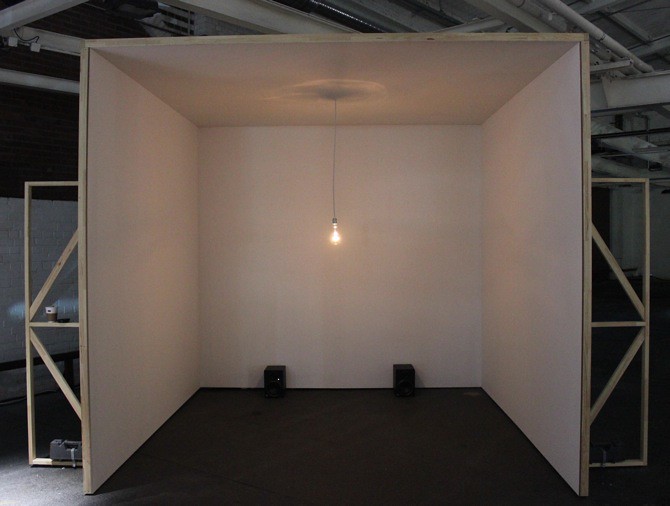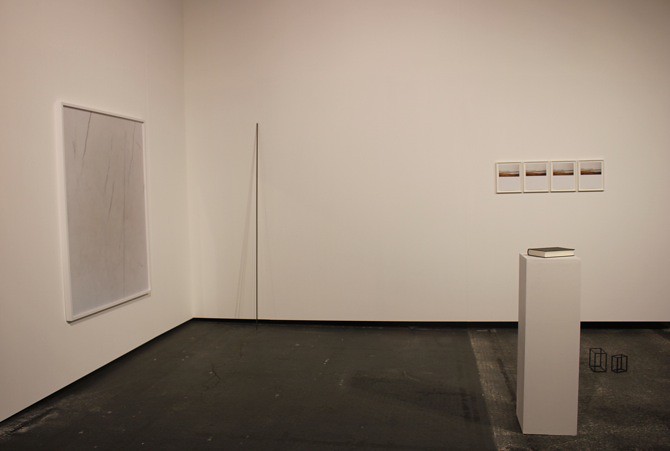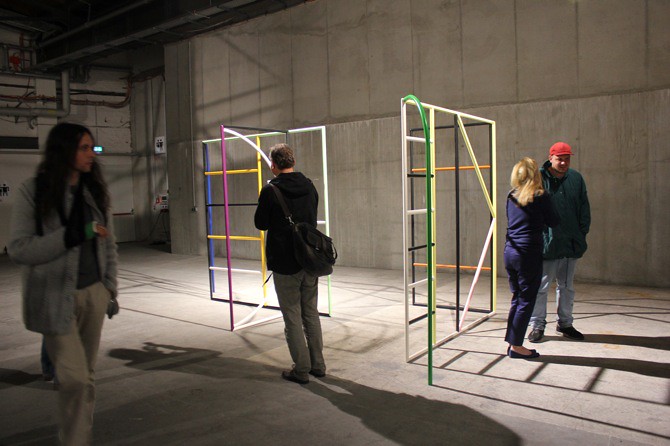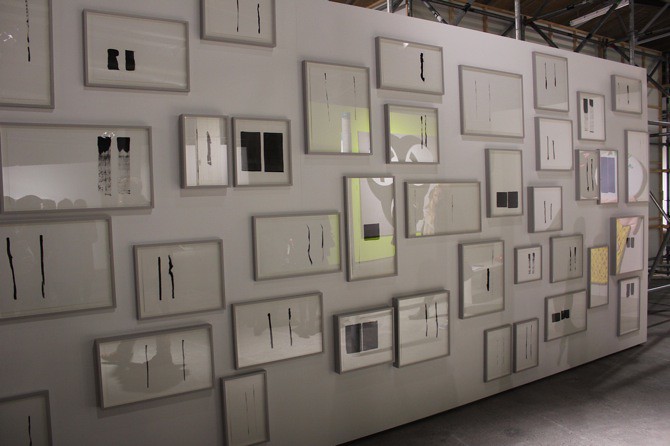Ugo Rondinone photographed by Piotr Redlinski for The New York Times, 2013. © Piotr Redlinski / The New York Times.
This art is timeless.
Some called it “primitive feel”; some called it “ancient contemporary”; some called it “transcending”… one thing for sure: this is timeless.
Some called it “primitive feel”; some called it “ancient contemporary”; some called it “transcending”… one thing for sure: this is timeless.
The notion of time is essential to the art of the Swiss-born, New York-based artists Ugo Rondinone (*1964). Time for the artist is never linear but circular. It takes the form of a singular, unique loop where “the past, the present and the future” coexist. It is this understanding of time that informs some of the artist’s motifs – the date paintings, the light, the repetitive sunrise and moonrise, the 24 hours, the universal emotions and desires, the human unconsciousness, the animals, the everyday objects, the landscape… “I see art-making as a ritual, a meditation for myself. […] The spending time or passing time is ritualized because there is no functionality in the art-making”. Being an artist for Rondinone is a philosophical task than merely producing objects.
The moment when you step in the galleries of Museum Leuven (Belgium) where the artist is having a mini-retrospective of works created during the last three years, you encounter the same feeling of timeless - here one second of life is captured and eternalized : a flock of birds standing quietly and motionlessly, snowflakes flutter slowly to the ground, fourteen nude dancers resting on the floor, monumental monochrome landscapes hypnotizing visitors into a state of trance, natural light secretly penetrating the galleries with spectrum colors through the clock-faced windows, poems gradually fading away from the walls...
Time would pass anyway.
Ugo Rondinone is also one of the most versatile artists today. Over the last decades, he took the liberty to cross the boundaries between different media and disciplines which allowed him to produce a strikingly diverse body of work that includes sculpture, painting, drawing, photography, video, writing and curatorial projects. His trance-inducing paintings and large scale drawings from nature, or site-specific installations are poetic and evocative in exploring emotional and psychic depth of human experience.
Selina Ting
InitiArt Magazine
Sept 2013, Bucharest
InitiArt Magazine
Sept 2013, Bucharest
UR – Ugo Rondinone
ST – Selina Ting for initiArt Magazine
ST – Selina Ting for initiArt Magazine
ST : This is the first time I visited a solo show of yours but I remember very clearly the exhibition The Third Mind that you curated for Palais de Tokyo (2007) in Paris. To start with, as an artist with curatorial talents, how do you approach the show, thank you silence, in Museum Leuven?
UR : First of all, this exhibit groups together several series of the work created in the last three years, except the titling piece thank you silence which was made in 2005. I see the exhibition as a crossing that brings together the notions of humanity, nature and our relations with the nature. At the same time, there are many binaries and dualities within the show, such as the contrasts between hard and soft, heavy and light, organic and inorganic, circular and geometrical forms, etc.
ST : I like the contrast between the materiality of the work and the immateriality of your handwritings throughout the exhibition space. It was a delightful experience to “see” the poems that you wrote directly on the walls in pencil. They are almost invisible and very ephemeral as they can be easily wiped off by careless visitors. While the site-specific landscape pieces are very self-imposing, the poems and the writings are self-effacing.
UR : It doesn’t matter if the writings are wiped off. Poetry itself is ephemeral. But yes, there is also the contrast between the presence of the materiality and the disappearance of the writings. The site-specific installations are monumental and they are in soil and in earthy tone. They are called “Landscape” because they created a mental space. They have a kind of mental power.
ST : They are very absorbing, just like poetry. My overall impression of the exhibit is that it’s very meditative. You hear your own voice whispering “keep quiet, keep quiet….” before the artist replies, “thank you silence”! When you circulate among the flock of birds in the first room, for example, you unconsciously soften your steps so as not to frighten them. While birds are traditionally seen as a symbol of vitality and freedom and always portrayed either in flying or taking-off position, your 59 birds are so meditative that we don’t even see their wings. But birds are not supposed to ignore their wings…
©Ugo rondinone, Primitive, 2011. Cast Bronze. Installation view of Ugo Rondinone, thank you silence, 2013. Museum Leuven. Courtesy of Studio Rondinone and Museum Leuven © DIRK PAUWELS.
UR : I have never thought about it but it’s nice to hear that and to think about it now. Let’s say that’s something I did unconsciously and you found it! For me, the importance of the birds is the perspective of the viewer. You have the impression of looking down at something small. However, the little birds stand for something bigger than what you expect because each of them represents a natural phenomenon from Moon, Mist, Air to Cloud, Mountain, Milky Way, etc.
ST : The series of birds is called “Primitive”. Together with “Primal” (Horses) and “Primordial” (Fishes), they form the three-group project . Other than the fact that they are pre-human creatures, what do these terms/titles speak to you?
UR : They link to something basic and primary. The three groups do have some similarities among them. They are all consisted of 59 pieces of standing creatures that represent different natural phenomenon. I started with the birds, now I am making the horses, the last one would be the fishes. It’s very important that I make them in clay, a very basic and down to earth material. The finger prints on the clay allow you to see the primal gests of creativity, of the artist’s thought and process. Even though the birds are cast in bronze, they remained very raw in terms of texture, colour and process.
ST : Both the 59 birds and the 14 nudes [nude Series] are posed on the floor without pedestal. They are very grounded and static, but seem to be quite lost…
UR : They are both very basic. Many people think that the nudes look sad or tired or lost, but that’s an evaluation. In fact, they are just passive, just being themselves without any activity or conscious evaluation. “Activity” sets up all the values. “Passivity” for me is a protection against setup values because when we are passive, we don’t say “yes” or “no”, we are just being passive. In that sense, the nudes’ passivity creates a value, maybe a value of the “slowness” that they are just “being”, resting.
Ugo rondinone, nude, 2011. Wax, earth pigments, steel rods, and polyurethane foam. At centre: standing landscape, 2013. Site-specific. Installation view of Ugo Rondinone, thank you silence, 2013. Museum Leuven. Courtesy of Studio Rondinone and Museum Leuven ©Dirk Pauwelst.
ST : There is a contrast between the smoothness of the texture and the fracture in the structure of the nude series. Do you purposely leave open certain joints in the same way as you left finger prints on the birds?
UR : The bodies are fractured because the body cast was made in 14 to 20 separate parts. It’s very difficult to have the models stay still in such a process and I didn’t bother to correct it when an arm or a leg is shorter. This created the fractions and disconnections of the body in the sculptures. The wax and the colour of the sculptures are very basic and earthy as if the nudes come alive through earth pigments. They are organic in contrast to the geometric form of the landscape series which is also made out of earth. They are exposed and vulnerable because they are nude; but at the same time they are protected because the colour and the material act like a camouflage. If you put them in the wood, they would disappear.
ST : They are vulnerable but they also have an athletic body.
UR : They are dancers between the age of 20 and 30. They are in their prime energy time and they are swiftly alert. I wanted to contradict this energy in a passive situation. When you are active, you are functioning. I want to have a non-functioning situation where “slowness” is the primary force.
UGO RONDINONE, nude (xxxxxxxxxxxxx), 2011 © the artist. Photo: Stefan Altenburger Photography, Zurich - Courtesy Gladstone Gallery, New York and Galerie Eva Presenhuber, Zürich © studio rondinone
ST : My understanding of “slowness” in your work is related to time and emotion. There is the inertia where “slowness” is perceived in a static motion, and emotionally, it evokes the Blasé attitude as a form of resistance. In a society obsessed with speed and acceleration, why do you value “slowness” over acceleration? What does it represent to you?
UR : There are different levels. The idea of “speed” is made with us that you have to be “somewhere” in time. So speed is almost controlling over us. “Slowness” is when we are in control of our own time. Another level is that, I believe the power of art is in its “slowness” in the sense that I am not in competition with technology; I am not in the competition of making art; I am not industrializing my art that I have to hire assistants in order to be competitive. So I would still have the romantic image of an artist working in solitude. This is my primary motivation of doing art – I can organize my time for myself. That’s why I always exclude society in my exhibitions which become the symbol of isolated space.
ST : There is the “slowness” in the image and in the art-making process. But there is also another rule of the game that each bird was made within one day, this imposed another relationship to or perception of time and speed.
UR : It’s about the immediacy. The birds are made in a naïve way, almost like clay toys made by children. So you have this immediacy, primary gests in the first room and the children’s drawings [your age and my age and the age of the sun (2013)] in the last room. At the same time, the birds bear my singularity as they are full of my finger prints. They are almost like a comical identity, a cartoon of you that you put a finger print on it. Let’s say, even if all the motifs that I am using in my work are common and banal, they are always in one way or another related to me.
Installation view Ugo Rondinone, your age and my age and the age of the sun, 2013. M – Museum Leuven. © Dirk Pauwels
ST : Both the idea of “one bird within the day” and the finger prints are very ritual.
UR : I see art-making as a ritual, a meditation for myself. It’s to exclude myself from society and to create my own rites. The spending time or passing time is ritualized because there is no functionality in the art-making. Time would pass anyway… The energy of art is that you can spend time with yourself. It’s not about producing objects and having assistants. Doing art and being an artist is a philosophical task than merely producing objects.
ST : That’s why you said in a previous interview that the « duration » in art-making is important. I quote it from French: “In my work, I like to slow down and prolong the temporality in which nothing would ever end or be abandoned; where everything can reappear or re-animate itself; where past, present and future belong to one single and unique loop”. Is the idea of making works in series similar to the perception of time in a circular motion?
UR : Yes, definitely. There are many possibilities for metamorphosis. Now after 20 years of making art, retrospectively, I see that many works are in fact not in a linear progression, such as one series after another. It’s more about not evaluating something. This is the notion of passivity or slowness, i.e. if you set the direction or a value, then you would function on the system of “exclude”. I don’t want to exclude, I want to include and be open. “Passivity” includes things because you are like an empty space open to all kind of possibilities.
ST : I have never heard of such a positive definition of “passivity”!
UR : Good! [Laughs] But it’s also a protective mechanism. I want to be as open as possible. Passivity is a way to protect yourself because people can’t pinpoint you down to a narrow definition. This passivity also energizes the work and brings emotions to the work. If I would set a value to the work, it would stop the work to grow. Once you define a work and you know what you are doing, then you just stop the work. There is no more vitality in it.
UGO RONDINONE, Soul (2013), a group of 37 figures from approximately 3 feet to 7 feet tall. Installation view at the Gladstone Gallery. Photo by David Regen. Courtesy of the artist and Gladstone Gallery, New York and Brussels.
ST : Between Art, Time and Poetry, there is something in common -- their shapelessness, indefinability, ambiguity… in constant mutation.
UR : Poetry fascinates me because there is the connection to visual work. The language of poetry is a slow motion language. It’s full of suspension, ambiguity, slowness… We have the impression that poetry defies any logical approach, but poetry is aesthetic in logic. That’s the force of it. I believe that it’s similar to art. I never stand in front of an art work and start thinking, and I would never understand why an artist would even explain himself/herself because that’s not the energy or the force of the work.
ST : [Laughs] My apologies for the interview!
UR : [Laughs] Art is always bigger than what we can think about or talk about! Every good art has the power to stop me, to suspend me. I am not anymore the way I was before. A magic moment has happened and it transformed me…
ST : Transported you!
UR : Transfixed me!
ST : [Laughs] We are literally opposite yet talking about the same thing!
UR : [Laughs] You see how fluid these values are! “Transport” or “transfix”, they are the same ambiguous thing!
ST : The titles of your work is also like a word-game ! They are either as “demanding” as a poem or as “lazy” as the 24 hours of a day [Light Bulb series]…
UR : Yes, but that’s more a system or a way to organize myself when I have a group of work. For example, the scholar rock series (2009) has a title made up of 17 words [“WE run through a desert on burning feet, all of us are glowing our faces look twisted”], each specific word is related to one specific sculpture. There is only a slight change of having one word in capital letters to designate that specific work. It’s a small help in the sense that I don’t need to find 17 titles for the 17 pieces. Together, they create a poem. Individually, each single word has its unique power. Or, with the doors series, there are 26 titles start with the 26 alphabets and stand for the 26 doors, like “Dear Deepest Dream”, etc. This kind of system grants my work a certain order. Another example is the Date Paintings, I don’t need to say if the series is over or not because the days continue, and I just continue the series. It gives me the openness in a way. So, it’s an excuse, an order, a system, etc.
I have a love and hate relationship to words. I am fascinated by words in general. I wrote looping dialogues in simple English. Like what you have just quoted on the notion of time and duration, these dialogues would never end or be abandoned. Writing is also a kind of language exercise for me when I moved from Switzerland to the States. But I am a visual artist. I would like to deal only with visuality than word.
ST : Thank you very much!
UGO RONDINONE, Where Do We Go From Here?, neon, Perspex and translucent film, 1999.
UGO RONDINONE
thank you silence
thank you silence
27.06 - 06.10.2013
M - Museum Leuven
L. Vanderkelenstraat 28
3000 Leuven
Belgium
www.mleuven.be
L. Vanderkelenstraat 28
3000 Leuven
Belgium
www.mleuven.be
About the Artist
Ugo Rondinone was born in 1964 in Brunnen, Switzerland. He lives and works in New York in the United States.
His work has been exhibited globally, from Le Consortium in Dijon (1997) to the Kunstverein in Stuttgart (2002) and the Centre Georges Pompidou in Paris (2003). He represented Switzerland at the 52nd Venice Biennale (2007) and was also the curator of the exhibitions The Third Mind at the Palais de Tokyo in Paris (2007) and The Spirit Level at Barbara Gladstone Gallery in New York (2012). More recently, he has had solo exhibitions at the Aargauer Kunsthaus (2010) and at the M.U.S.A.C. in León (2011).
Ugo Rondinone was born in 1964 in Brunnen, Switzerland. He lives and works in New York in the United States.
His work has been exhibited globally, from Le Consortium in Dijon (1997) to the Kunstverein in Stuttgart (2002) and the Centre Georges Pompidou in Paris (2003). He represented Switzerland at the 52nd Venice Biennale (2007) and was also the curator of the exhibitions The Third Mind at the Palais de Tokyo in Paris (2007) and The Spirit Level at Barbara Gladstone Gallery in New York (2012). More recently, he has had solo exhibitions at the Aargauer Kunsthaus (2010) and at the M.U.S.A.C. in León (2011).
The work of Ugo Rondinone is represented by Galerie Eva Presenhuber (Zürich), Barbara Gladstone Gallery (New York – Brussels), Galerie Almine Rech (Paris – Brussels), Sadie Coles HQ (London) and Galerie Esther Schipper (Berlin).
www.initiartmagazine.com









 Nina Canell at Konrad Fischer
Nina Canell at Konrad Fischer Luca Trevisani at Mehdi Chouakri
Luca Trevisani at Mehdi Chouakri  Andrew Kerr at BQ Berlin
Andrew Kerr at BQ Berlin  Ull Hohn at Galerie Neu
Ull Hohn at Galerie Neu  Mie Olise at Duve Julius von Bismarck at alexander levy
Mie Olise at Duve Julius von Bismarck at alexander levy  Timo Klöppel at KWADRAT Tony Oursler at Aviskarl Gallery
Timo Klöppel at KWADRAT Tony Oursler at Aviskarl Gallery Ulrich Vogl at Galerie Opdahl
Ulrich Vogl at Galerie Opdahl  Thea Djordjadze at Sprüth Magers
Thea Djordjadze at Sprüth Magers  Daniel Gustav Kramer at Sies + Höke
Daniel Gustav Kramer at Sies + Höke  Marie Letkowski at Galerie M + R Fricke
Marie Letkowski at Galerie M + R Fricke  Muntean / Rosenblum at Galerie Zink
Muntean / Rosenblum at Galerie Zink  David Lynch at Galerie Karl Pfefferle
David Lynch at Galerie Karl Pfefferle  Eva Berendes at Sommer & Kohl
Eva Berendes at Sommer & Kohl  Danilo Duenas at Galerie Thomas Schulte Mark Flood at Peres Projects
Danilo Duenas at Galerie Thomas Schulte Mark Flood at Peres Projects  Tomas Saraceno at Esther Schipper
Tomas Saraceno at Esther Schipper  Diana Sirianni at Figge von Rosen Galerie
Diana Sirianni at Figge von Rosen Galerie  Hermann Nitsch at Studio Morra / Alnitak Art Agency
Hermann Nitsch at Studio Morra / Alnitak Art Agency  William Tucker at Buchmann Galerie
William Tucker at Buchmann Galerie  Tilo Schulz at Jochen Hempel
Tilo Schulz at Jochen Hempel  Thomas Zipp at Galerie Guido W. Baudach
Thomas Zipp at Galerie Guido W. Baudach  Andreas Fischer at Johann König
Andreas Fischer at Johann König